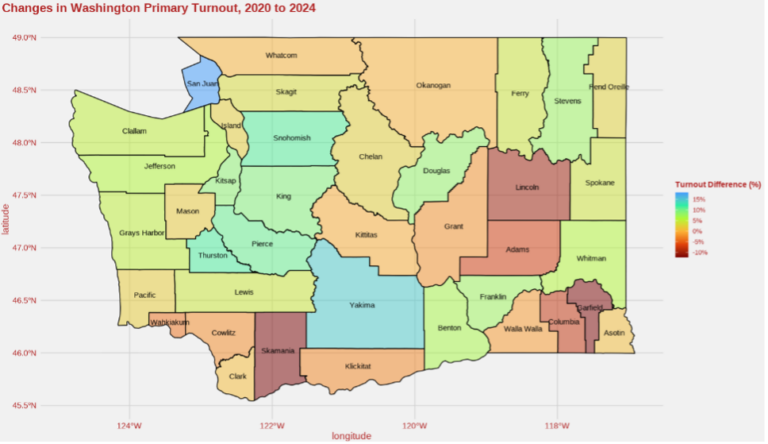The Democrats have finished their convention, and the Harris/Walz ticket is officially official. The Democrats are undoubtably happy with the attendance, energy, and attention from the convention. Some of the show timing was a little odd – it isn’t often that both the sitting President of the United States and the party’s current candidate both take the stage after primetime on the east coast – but the response from the party faithful seems to have been very positive. Politico has a good topline here for the overall swing since Harris replaced Biden at the top of the Democratic ticket.
With 74 days left we are now in the final sprint. Some words of caution from the Democratic side on getting too optimistic based on some of the public polling can be seen here.
Moving to the battle for control in the U.S. Senate, let’s start in Arizona. The latest New York Times/Sienna has Harris up 4 here now (right around the MoE). In a state where just over 20% of the electorate is Hispanic Harris’ 6% improvement over Biden in the crosstab is important here, as are her movements with Independents and women (particularly non-college educated women). This is a change from a minimal Trump advantage in previous weeks, so we’ll see if it is sustained. On the Senate side it is safe to say that Democrat Ruben Gallego enjoys and advantage. Last week had the race Gallego +2%, the New York Times/Sienna had it at Gallego +9%. (Much of that difference is likely attributable to a difference in the Likely Voter universe. If there is interest, we can look at how registered voter vs likely voter surveys are constructed, and the tools used in establishing a likely voter universe.)
As mentioned last week, Pennsylvania is razor-close at the Presidential level. (With Kennedy a factor vs. a head-to-head race). In the Senate race, however, every public poll in August has Casey ahead. We don’t have anything new to add this week. When you dig in the breaks for independents, college+ men, and less than college women all favor the Democratic candidate over the generic party expectation.
In Montana we have seen a surprising amount of money spent or reserved on media buys – closing in on $60 million on each side, according to our friends at National Media. Those are impressive resources when you are trying to reach a total population of only ~750,000 voters. The last two polls released here have Tester +5 and Sheehy +6% – and were in field at the same time. Make of that what you will, though this may be a response rate phenomenon so let’s keep an eye out.
It’s worth taking a quick look at some Presidential battlegrounds with no Senate races this year in Georgia and North Carolina. In Georgia we find the Presidential race close, with results across all released polls showing anything from a tie to variety of small Trump leads. Even those leads of a few points are much less than Trump’s comfortable leads against Biden. Harris’ 10%+ movement with Black voters looks to be at the root of this change.
In North Carolina we have seen results ranging from a Trump +3% to Harris +4% in the past 10 days. This is a state the Democrats haven’t won in the Presidential race since 2008 and were not expecting to win this year either. If they manage to do so it would enormously complicate the electoral college math for the Trump campaign, but would be a major shift to sustain through election day. Also to note, the underperforming Republican Gubernatorial campaign of Mark Robinson is consistently failing to break 40% in statewide LV polls. This might prove a drag for Trump at the Presidential level.
Also worth a little thought are the results of the Washington primary earlier this month. Washington uses a ‘jungle primary’, in which the top two vote-getters advance to the November ballot regardless of party affiliation. The combination of this structure and the August timing has made Washington something of a bellwether for recent cycles – much to the excitement of Democrats following their D +16% popular vote performance in the popular vote this time. So, what happened?
Using an individual voter history-based approach, increases in turnout seem to be driven by new movers. In particular, it looks like postgraduate educated new movers in high tech sectors. As a result, this year’s primary probably skews more left than previous years, so we should be cautious about the wider applicability of the result. We also see turnout dropped in more rural and suburban areas, particularly when not bolstered by the Seattle media market.

This is a red flag for Republicans in the Midwest: if populations the GOP is counting on are turning out at a reduced rate, then a concentrated and effective GOTV effort may be required with audiences not currently included on high-priority GOTV targeting lists.
Want to talk about the data more in-depth? We’re here to talk.
Alex Muir (amuir@wpaintel.com)
Connor Sandagata (csandagata@wpaintel.com)
Amanda Iovino (aiovino@wpaintel.com)
Conor Maguire (cmaguire@wpaintel.com)
